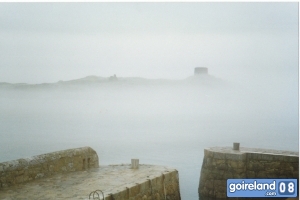Ireland’s coastline and inland lakes are scattered with hundreds of islands, ranging from scraps of land no bigger than rocks to larger settlements that are home to thriving communities. Below you will find a selection of some of Ireland’s most beloved islands.
Inishbofin Island
Inishbofin, Galway
Located off the west coast of County Galway, Inishbofin remains one of Irelands best loved islands. It was singled out by St Colman as the location for his monastery because of its tranquillity, and the same serenity surrounds the island today.
The outdoor enthusiast will enjoy the sheltered beach coves and Europe’s clearest blue waters, with experienced divers drawn to explore the aquatic life of the Atlantic Ocean, and fishermen inspired by the prospect of deep-sea and rock angling. For the history buff, there are many Celtic and early Christian fortified habitations be found on the island. Nature lovers will be captivated by the number of bird sanctuaries on the island. The friendly local Community Club hosts traditional music sessions, frequent folk dancing, and ceilis.
Saltee Islands
These islands off the south coast of Wexford are a haven for sea birds. Together, Great and Little Saltee form Ireland’s largest bird sanctuary, attracting an impressive array of birds, from gannets and gulls to puffins and Manx shearwaters. Great Saltee is particularly famous for its colonies of cormorants. It also has more than 1,000 pairs of guillemots and is a popular stopping-off place for spring and autumn migrations. A bird monitoring and research programme is in progress, and a close watch is also kept on the colony of grey seals. The two uninhabited islands are privately owned, but visitors are welcome. Boat trips are run in fine weather from Kilmore Quay.
Dalkey Island
Dalkey, Dublin
Located 300 yards offshore from Coliemore harbour, Dalkey Island is uninhabited, and its main interest is the early church dedicated to Saint Begnet near the landing place on the west shore. It has prominent antae and a massively lintelled doorway with slightly inclined jambs. The original roof was probably thatch or shingles, but medieval slates discovered in the course of excavation show that the church remained in use for some considerable time. The bell cote on the west gable is also a late addition.
Alterations were made to the interior of the building at the beginning of the 19th century when it was temporarily occupied by the workmen who constructed the Martello tower on the island.
On a weathered rock outside the church is an inscribed cross in a circle, a relic perhaps of the first monastery here, possibly in the sixth or seventh century.
Devenish Island
Devenish Island is the site of a 6th-century monastery founded by St. Molaise, which was raided by the Vikings in the 9th century and burned in 1157. The island’s greatest treasure is an early 11th-century book shrine which is now in the National Museum in Dublin. The remains on the island include a perfect round tower and St. Molaise’s house, 13th-century church ruins, 11th-century gravestones, Augustinian priory, and a 15th-century cross.
Brown’s Bay
Islandmagee, Antrim
The most popular tourist spot on Islandmagee, Brown’s Bay has a beautiful, safe sandy beach bounded by hills on either side. It is an ideal spot for bathing, and a popular place for picnics. A walking route for Brown’s Bay takes visitors to the Rocking Stone, a prominent local landmark on the shore, and headlands which overlook the sea and the Maiden Rocks to the north. Nearby is Ferries Bay, another sandy beach location.
Inishmaan
Inishmaan, Aran Islands, Galway
Inis Meain, the middle island of the Aran Islands, with an area up to 900 hectares, is an island of immense rugged beauty, on which the traditional Aran lifestyle still prevails.
Until recently it was only possible to land on this island by curragh, but now an air strip has been built which links it with the Galway mainland and the two other Aran Islands.
The Skellig Islands
Valentia Island, Kerry
Skellig Michael, also known as Great Skellig, is an inhospitable pinnacle of rock rising out of the Atlantic and covering an area of 17 hectares. Perched on a ledge almost 218m above sea level and reached by a remarkable 1,000-year-old stairway is an isolated early Christian monastery. Monks sought solitude on Skellig Michael during the 6th century, building a cluster of six corbelled beehive cells and two boat-shaped oratories. These dry-stone structures are still standing, despite being raked by storms over the centuries. The monks were totally self-sufficient, trading eggs, feathers, and seal meat with passing boats in return for cereals, tools, and animal skins. The skins were needed to protect the vellum on which the monks copied their religious manuscripts. They remained on this bleak island until the 12th century, when they retreated to the Augustinian priory at Ballinskelligs on the mainland. Today the only residents on Skellig Michael are the thousands of sea birds that nest and breed on the high cliffs, including storm petrels, puffins, and Manx shearwaters.
Blasket Islands
Dun Chaoin, Dingle, Kerry
At the most westerly point Europe lie a unique group of islands, which were inhabited for thousands of years and finally abandoned in 1953, when the last inhabitants were moved to the mainland. On the Great Blasket, life has stood still. It has electricty, no phone, no television, no cars; only the sound of the sea, the cry of the gulls, unspoilt beaches, extraordinary bird life, and a uniquely peaceful atmosphere.

